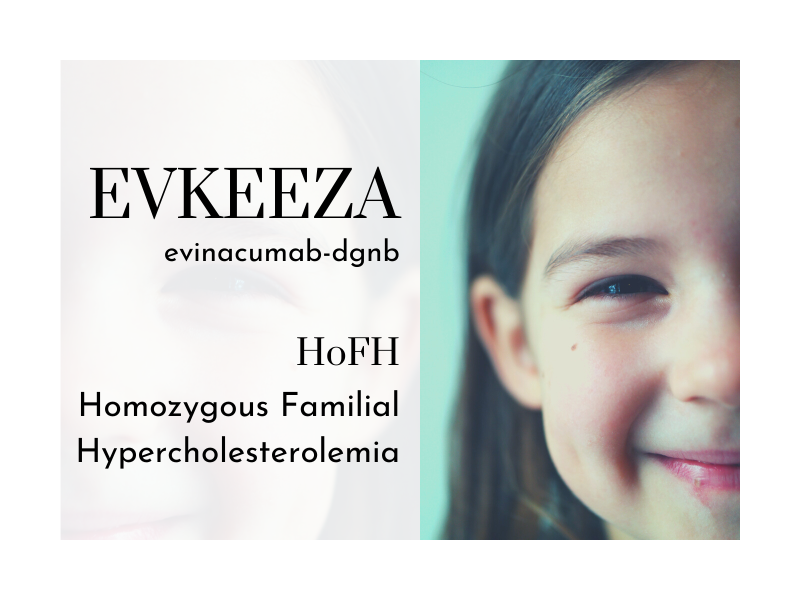Evkeeza (evinacumab) reduces LDL cholesterol levels in children with an incredibly rare form of high cholesterol disease.
We all know about good cholesterol and bad cholesterol. Good or high-density lipoprotein (HDL) guides the cholesterol accumulating in our arteries to the liver, where it eventually gets flushed out. Bad or low-density lipoprotein cholesterol (LDL-C) not only makes up for most of the cholesterol in our body, but also contributes directly to fat buildup in our arteries. High LDL-C can increase the risk of heart disease and stroke.
What happens when the liver is unable to process bad cholesterol due to genetic factors?
Familial hypercholesterolemia (FH) is a hereditary disorder. It is one of the common genetic causes of premature coronary heart disease. When a child born from parents with FH genes, inherits one FH gene from each parent, they might develop homozygous familial hypercholesterolemia (HoFH). This is an ultra-rare but life-threatening condition that is marked by elevated levels of circulating LDL-C.
HoFH affects approximately 1300 people in the US and 1 in 160,000 to 300,000 people worldwide. When left untreated, most patients go on to develop xanthanomas (small skin lesions with fat buildup) and atherosclerosis (fat buildup in arteries). Children suffering from HoFH develop xanthanomas within the first few years of their life. This disease can also result in early fatalities.
This condition is caused by mutations in two genes — apolipoprotein B (APOB) and proprotein convertase subtilisin/kexin type 9 (PCSK9) — and is characterized by the patient’s inability to break down LDL particles and to clear LDL-C from the liver. APOB is responsible for synthesizing LDL while PCSK9 facilitates its degradation. In the absence of these two important functions, APOB does not bind to LDL while PCSK9 is unable to degrade it, leading to an accumulation of recycled LDL.
Although early diagnosis followed by diet and lipid-lowering therapies and parental genetic testing are critical and beneficial to controlling the severity of this disease, they are not enough to treat HoFH.
Regeneron recently announced that Evkeeza reduced LDL-C by 48 percent after a 24-week treatment period in children with HoFH. Evkeeza — generically known as evinacumab — is a monoclonal antibody. It is the first US Food and Drug Administration (FDA)-approved and European Commission-approved therapy that targets angiopoietin-like 3 (ANGPTL3) for patients aged 12 and older with HoFH.
“Children living with HoFH have an incredibly rare and severe disease that causes dangerously high LDL-C levels. On current treatment options alone, many patients don’t reach their treatment goals, leaving them with an uncertain future,” said M. Doortje Reijman, trial investigator and research associate in Pediatric Metabolic Diseases and Nephrology at the Amsterdam University Medical Center.
How does Evkeeza Lower Cholesterol Levels?
Evkeeza works by binding to and blocking the function of ANGPTL3, which is a protein that plays a role in lipid metabolism. The ANGPTL3 protein inhibits the enzyme activity of lipoprotein lipase (LPL). A decrease in the activity of LPL has been associated with a rise in plasma triglycerides and a lowering of HDL cholesterol. Previous research established that patients who displayed “loss-of-function mutation” in the ANGPTL3 gene had significantly lower levels of LDL-C, thereby reducing the risk of coronary heart disease.
“Evinacumab has already demonstrated significant LDL-C reductions in adolescents and adults with HoFH. This latest Phase III trial illustrates the potential of this medicine to be a breakthrough HoFH therapy for children as young as 5-years old, helping them control their LDL-C early in the course of their disease,” Reijman added.
The Trial
The study (NCT04233918) was Part B of an ongoing three-part, single-arm, open-label Phase III trial that evaluated the safety and efficacy of Evkeeza (evinacumab) in children aged five to 11 years. The patients were at the average age of nine years. These children received different lipid lowering medications that treated blood cholesterol, lipid abnormalities and lipoproteins along with Evkeeza. Participants entered the trial with twice the amount of LDL-C content than was the target for pediatric patients with HoFH and received Evkeeza intravenous injections (IV) at 15 mg/kg every four weeks for 24 weeks. During this time, they continued with their other lipid-lowering regimen.
The primary end point was a reduction in LDL-C at week 24. The cholesterol levels were reduced by at least half in 79 percent of the patients, and they observed an absolute reduction of 132 mg/dL in LDL-C levels from baseline. The secondary endpoint was to check the effect of Evkeeza on other lipid parameters (apolipoprotein B, non-high-density lipoprotein cholesterol, lipoprotein(a) and total cholesterol), efficacy by mutation status, safety and tolerability, immunogenicity and pharmacokinetics (PK).
The drug was well-tolerated by patients except for two adverse events that were deemed unrelated to the therapy. The most common adverse events were throat pain, upper abdominal pain, diarrhea, headache and nasopharyngitis.
Regulatory authorities have yet to evaluate the use of this drug in children aged five to 11 years with HoFH. This study does not determine the safety and efficacy of the drug on patients suffering from other causes of high cholesterol such as heterozygous familial hypercholesterolemia (HeFH). In addition, they did not test for cardiovascular morbidity and mortality.
The Technology that Brought About Evkeeza
Evkeeza was created using Regeneron’s VelocImmune technology. In a 2013 press release statement, Regeneron chief scientific officer George D. Yancopoulos said, “VelocImmune provides perhaps the most powerful and efficient way of generating fully human monoclonal antibodies that are ready for clinical testing. Its invention has allowed Regeneron to become a leading antibody therapeutics company, with twelve clinical stage antibodies generated through our VelocImmune platform currently in clinical development.”
The VelocImmune technology is part of Regeneron’s suite of technologies that were designed to accelerate the drug discovery and approval timeline. This particular platform creates fully human monoclonal antibodies from immunized mouse models — labeled VelocImmune mice — with a genetically humanized immune system. These antibodies bind strongly to their target and provide a robust immune response.
Ongoing and Future Studies
Part B of the three-part study evaluated the effects of Evkeeza in children with HoFH. Part A involved assessing the safety profile of the drug. Patients who completed Part A or B continued treatment to Part C, an ongoing extension of the Phase III trial. Regeneron presented detailed results of the Phase III trial at the 5th European Atherosclerosis Society Pediatric Familial Hypercholesterolemia symposium. The company will prepare an FDA submission later this year.
Although cardiovascular studies for Evkeeza have yet to be conducted, the acceptable side effects and current benefits of this drug make it a good candidate for cholesterol reduction. It has been authorized under “exceptional circumstances” in the EU.
“The FDA’s approval of Evkeeza is a watershed moment for individuals born with HoFH, a severe form of familial hypercholesterolemia,” said Katherine A. Wilemon, Founder and CEO of the FH Foundation in Regeneron’s previous press release.
UK-based Amryt Pharma is recruiting for a single arm Phase III study to evaluate the lipid-lowering capabilities of lomitapide in children and adolescents with HoFH. Lomitapide is currently FDA-approved for use in adults with HoFH alongside a low-fat diet. Commonly known as Juxtapid/Lojuxta, lomitapide is an oral drug that works by reducing the absorption of cholesterol after a meal and the production and release of cholesterol from the liver.












Join or login to leave a comment
JOIN LOGIN